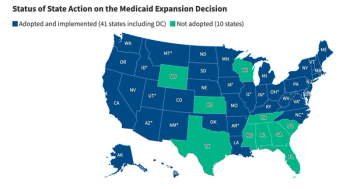
How to meet unique health needs of LGBT individuals
Finding ways to communicate directly with and provide tailored services to LGBT individuals has been a challenge for managed care organizations, but experts say breaking barriers is imperative.
Finding ways to communicate directly with and provide tailored services to lesbian, gay, bisexual, and transgender (LGBT) individuals has been a challenge for managed care organizations, but experts say breaking barriers is imperative. Research indicates that many LGBT patients have had negative experiences with healthcare providers, and that has caused many to stay out of the system.
“LGBT individuals are very likely to have experienced stigma and discrimination in medical settings and as such are often less likely to go to a doctor,” says Julia Applegate, MA, director of the Institute for LGBTQ Health Equity at Equitas Health, a healthcare system known for serving the LGBT community. “LGBT individuals are also disproportionately low-income, which means accessing insurance is often financially impossible.”
In October 2016, the National Institute on Minority Health and Health Disparities (NIMHD) designated sexual and gender minorities (SGM), including LGBT populations, as a health disparity population in order to increase healthcare research.
“Stigmatization, hate-violence, and discrimination are still major barriers to the health and well-being of SGM populations,” said Eliseo J. Pérez-Stable, MD, director of NIMHD, in a statement. “
High uninsured rate
It is difficult to measure how many LGBT individuals have healthcare coverage. The most accurate account comes from married lesbian and gay couples, and people who self-report to studies and polls.
“Even with the progress that's been made to date, LGBT people remain disproportionately unlikely to be uninsured relative to the general population. So, there's more work to do,” says Katie Keith, JD, MPH, member of the steering committee for Out2Enroll, an initiative launched by the Center for American Progress in 2013 to provide LGBT individuals with unbiased and accurate health reform information. “LGBT consumers are looking for insurance companies and plans that do not discriminate on the basis of sexual orientation or gender identity. This means, for instance, offering plans with family coverage for same-sex couples, making in vitro fertilization equally available to heterosexual and same-sex couples, and including fully transgender-inclusive coverage.”
Understanding challenges
Health challenges faced by LGBT patients are similar to the general population, though there are subtle differences, says Applegate. “The differences lie in the proportion of the LGBT community that suffers from common health challenges such as anxiety, depression, obesity and cancer,” she says. “The root of these health disparities are social norms and institutions that stigmatize, marginalize, and devalue the lives of LGBT individuals. All of these factors function as barriers to care and result in poor health outcomes.”
Keith says there is a misconception that people in transgender communities are more expensive to cover.
“Most transgender people have not undergone transition-related surgery and need access to only, say, hormone therapy or mental healthcare to treat their gender dysphoria,” Keith says. “A variety of studies show that offering fully transgender-inclusive health insurance is actually cost-effective and results in low actual costs despite high actuarial projections.”
Common barriers
Removing limitations on services, such as hormone therapy and gender affirmation surgeries and procedures, can make health plans more accessible to LGBT members, says Karen Rubin, education manager for the Institute for LGBTQ Health Equity.
“These procedures are often lifesaving and rather necessary and are infrequently fully covered by health insurance policies,” Rubin says, adding that step therapy, which requires a patient to use a less expensive drug at the outset, can make a patient in the LGBT community less likely to continue engagement with providers.
“LGBTQ folks often have negative experiences in a doctor’s office, resulting in a hesitancy to engage in care. Medication requiring step therapy requires folks to feel comfortable returning to a provider when a treatment regimen fails,” Rubin says.
Additional diversity training for clinical staff, specifically about LGBT patients, is one way to help LGBT members feel more comfortable with providers, Applegate says.
“On average, medical providers receive five hours of LGBT cultural competence training in their entire medical education, meaning few providers are skilled at working with the LGBT community,” Applegate says. “These problems are magnified in rural communities where there are fewer LGBT-friendly providers and a greater fear of being ‘outed’ when seeking medical care.”
Marketing to LGBT patients
Building relationships with LGBT individuals can be aided by providing educational support through events and partnerships. Keith says having presence at LGBT pride events with organizations such as PFLAG and Out2Enroll can be a first step.
“We can serve as a hub for appropriate messaging and can help plans with developing new partnerships and creating inroads to LGBT leaders,” Keith says. “However, LGBT leaders and community members will want to be sure that an insurer is truly LGBT-affirming, so we recommend that companies review their nondiscrimination and coverage policies to ensure that these are fully updated to be truly LGBT-inclusive.”
Applegate suggests that marketing materials are inclusive of LGBT populations, including images of same-sex couples and gender inclusive language. “I think it is also important to have a consistent presence in the community. Many organizations sponsor or participate in events related to Pride, but it is important to be involved year-round,” Applegate says.
Just like with other populations with less access to care, creating simple, easy-to-understand information about how healthcare coverage works is a way to remove communication barriers, Rubin says. “Having a series of one-page fact sheets detailing what the coverage options are for commonly prescribed treatments for LGBTQ folks will increase transparency, engagement, and knowledge of coverage options.”
Donna Marbury is a writer in Columbus, Ohio.
Newsletter
Get the latest industry news, event updates, and more from Managed healthcare Executive.





















































